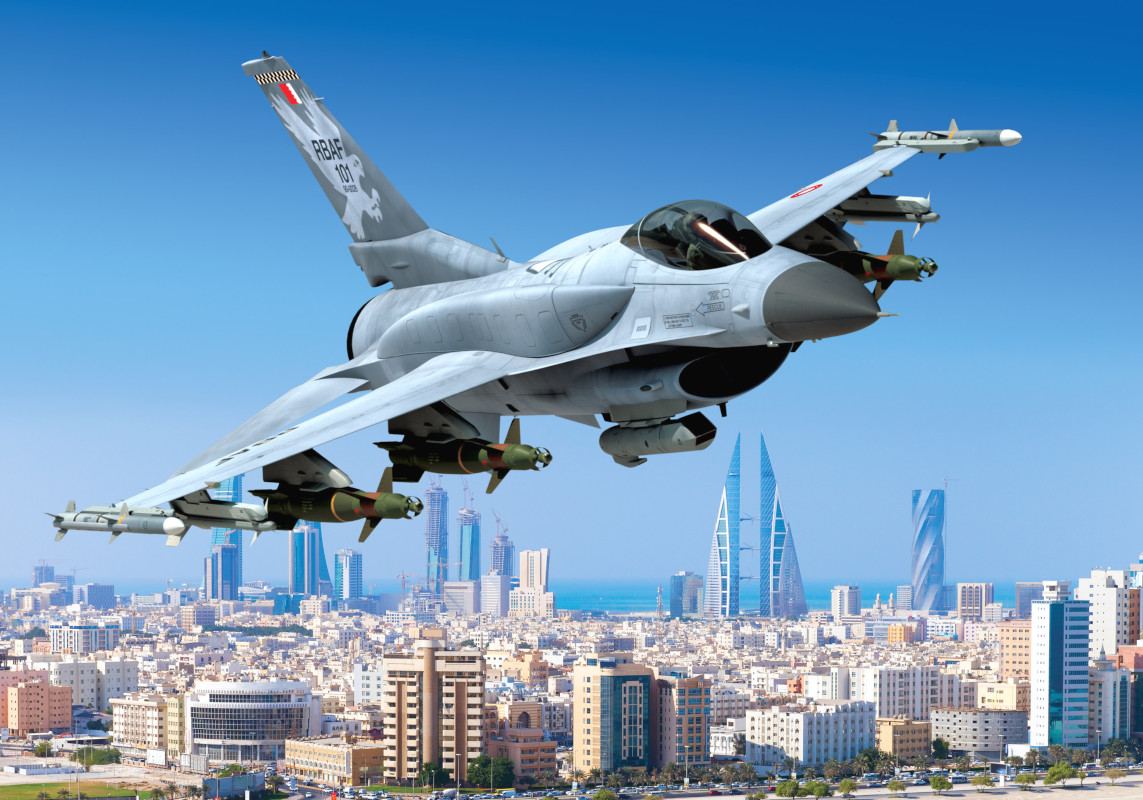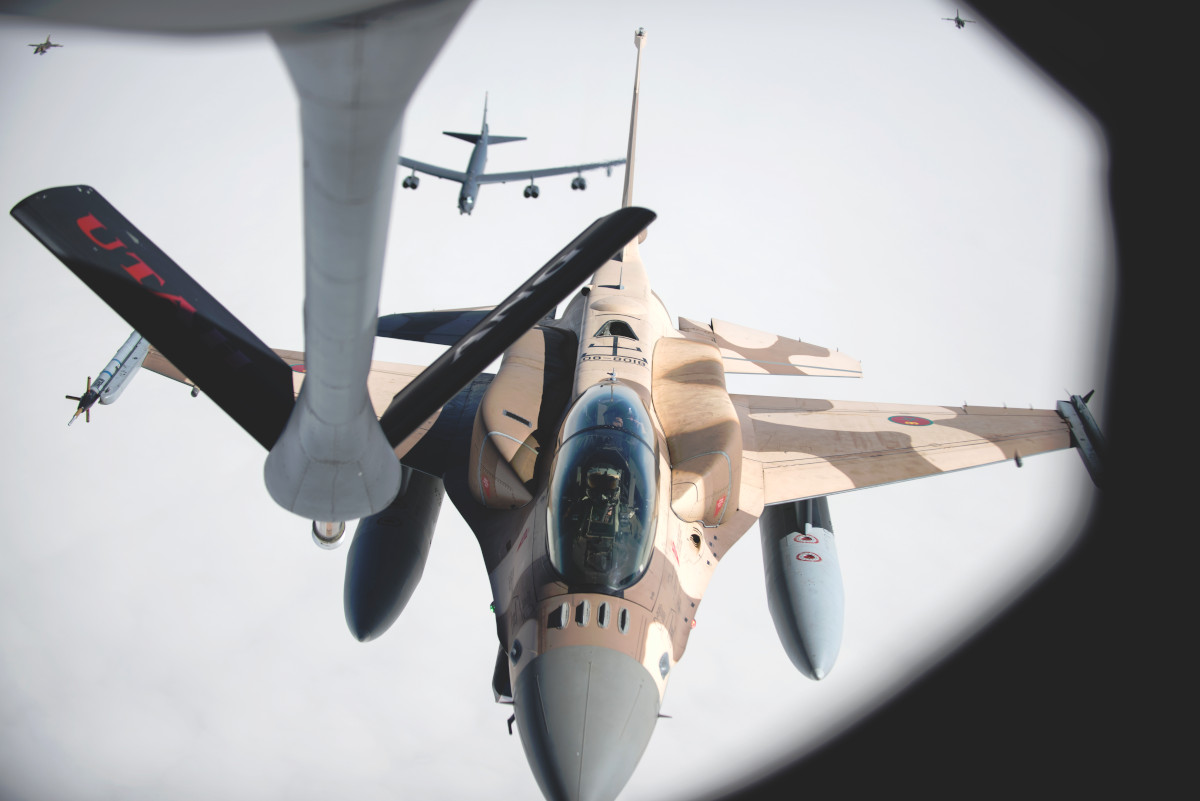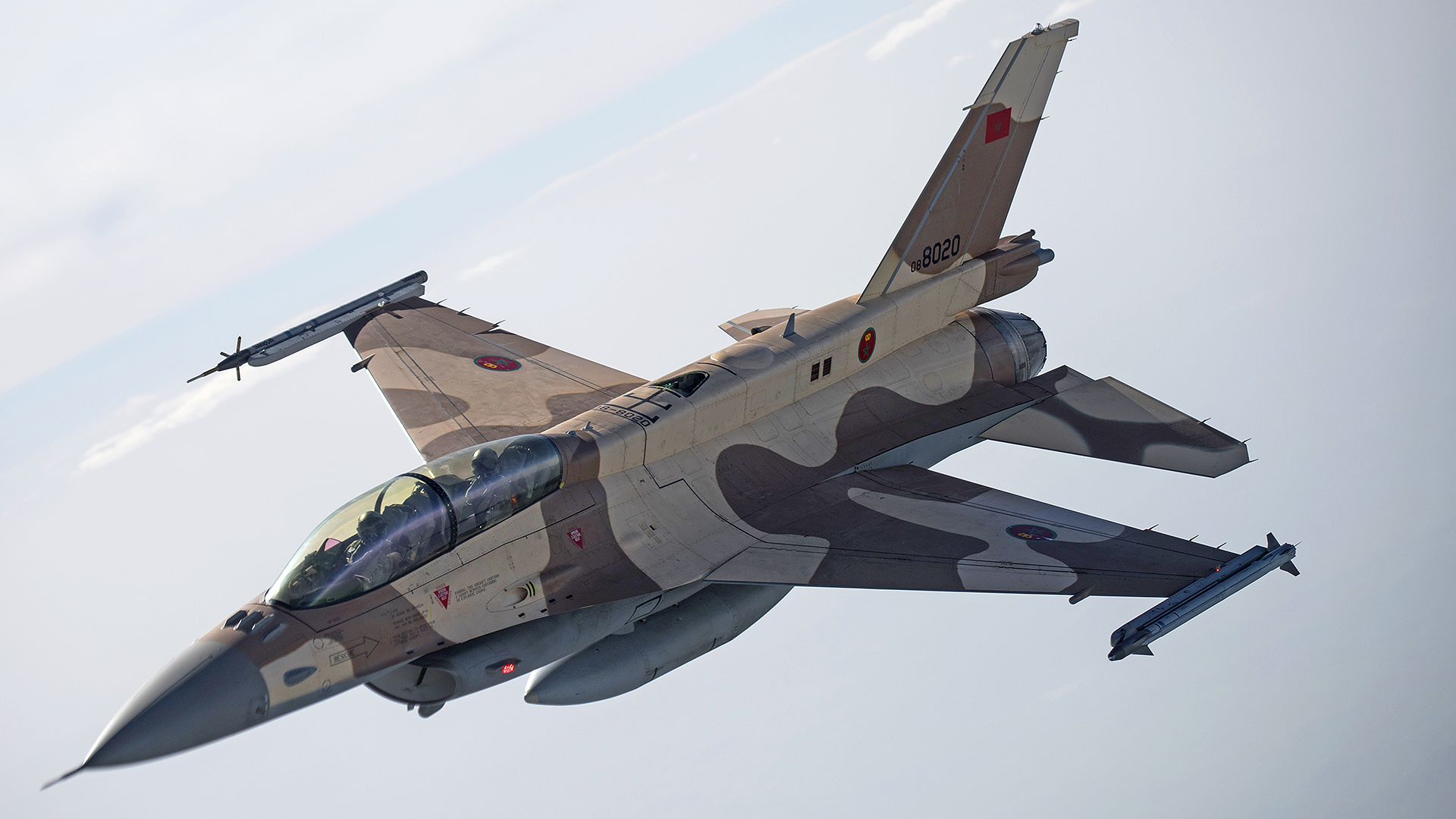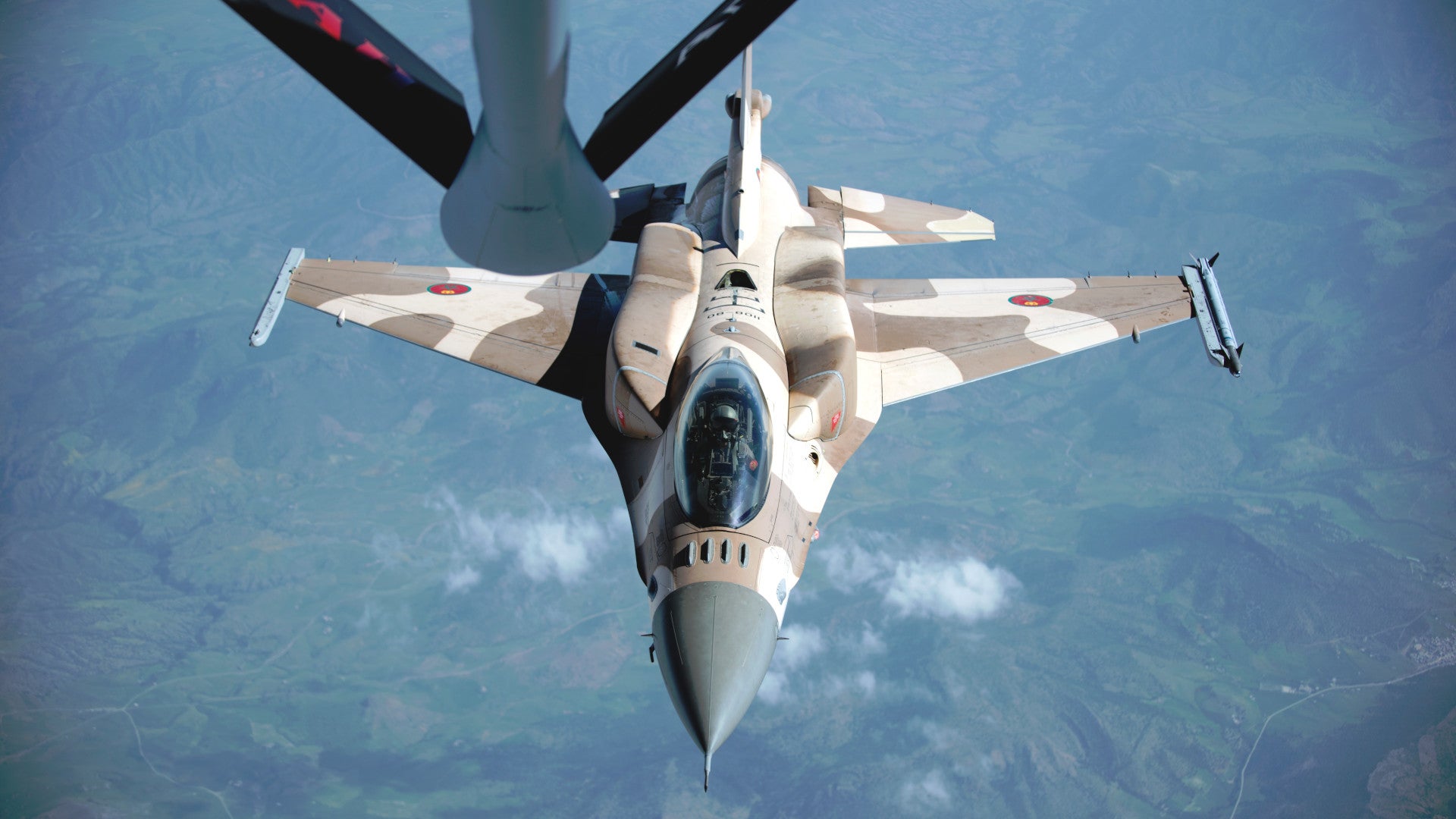The U.S. government has approved the sale of 25 new F-16 Block 72s to Morocco, as well as an upgrade package to bring that country’s existing Viper fleet up to the very similar F-16V standard. If the North African nation were to pursue both deals, it would effectively double the size of the Royal Morocco Air Force’s F-16 fleet and significantly increase its combat capabilities.
The Defense Security Cooperation Agency (DSCA), the U.S. military’s central foreign sales office, issued separate statements about the two potential deals on Mar. 25, 2019. The upgrade package, valued at more than $985 million, covers the cost of bringing the RMAF’s 23 existing F-16C/D Block 52+ aircraft up to the F-16V standard, as well as a variety of other ancillary items and support services. The purchase of the 25 new Block 72 aircraft, which also includes various other equipment, weapons, and services, comes with a price tag of $3.8 billion.
“The purchase will improve interoperability with the United States and other regional allies and enhance Morocco’s ability to undertake coalition operations, as it has done in the past in flying sorties against ISIS in Syria and Iraq,” the statement regarding the Block 72 aircraft says. “Morocco already operates an F‑16 fleet and will have no difficulty absorbing this aircraft and services into its armed forces.”
The press release regarding the F-16V upgrade deal includes similar language. Both notices also make mention of Morocco’s status as a major non-NATO U.S. ally and an important American partner in North Africa and elsewhere.

If Morocco does decide to buy the new-build aircraft, it would be the second country to purchase examples of Lockheed Martin’s most advanced F-16s to date and the first to purchase the Block 72 configuration specifically. In June 2018, Bahrain became the first customer for new F-16 Block 70 aircraft. Just last week, reports emerged that the U.S. government might also approve sales of the Block 70 to Taiwan.
The difference between the two subvariants is that the Block 70s have a version of General Electric F110 engine, while the 72s have the Pratt & Whitney F100 engine. Otherwise, both aircraft share all of the other significant upgrades over previous F-16s, including the AN/APG-83 Scalable Agile Beam Radar (SABR), an active electronically scanned array type, as well as an overhauled glass cockpit, new mission computers, an advanced electronic warfare suite for self-defense, improved data links, provisions for the Joint Helmet Mounted Cueing System (JHMCS), and more, which you can read about in more detail here.

Lockheed Martin originally developed the Block 70 for India, but recently rebranded that country-specific configuration as the F-21. The F-16V is an upgrade package for older Vipers that brings them up to a near identical standard to Block 70/72 aircraft. Taiwan and Greece are both upgrading their existing F-16 fleets to the V configuration, as well.
For Morocco, the potential purchases, including the upgrades, would dramatically expand the country’s air combat capabilities, while also creating a common standard across its entire Viper fleet. Its Block 52+ jets already use the F100-PW-229 engine, which they will retain when the go through the F-16V upgrade process. This means that all of the RMAF’s Vipers will share the same engine at the end of the day, helping to keep the service’s maintenance and logistical demands to a minimum.
Morocco’s Block 52+ aircraft were already among some of the more advanced Vipers out there and are very new by fighter jet standards, with the RMAF only starting to receive the aircraft in 2011. All of Morocco’s Block 52+ jets already have provisions for conformal fuel tanks and its two seat F-16Ds feature an enlarged dorsal spine, which can accommodate avionics, communications equipment, countermeasures systems, and more.
It’s also worth noting that the possible F-16V upgrade deal and the potential purchase of the new Block 72 jets each include six DB-110 intelligence, surveillance, and reconnaissance pods. Derived from the Senior Year Electro-Optical System (SYERS) for the U-2 Dragon Lady spy plane, this is an extremely capable system that can capture high-fidelity imagery and can do so at extended ranges using a slant flight profile. Already popular among Viper operators, the latest examples of the DB-110 offer multi-spectral sensor fusion capabilities, making the system even more powerful. You can read more about this system here.

A fleet of upgraded F-16Vs and Block 72 Vipers could only improve Morocco’s ability to contribute to future operations with the U.S. military. As DSCA noted, the RMAF’s existing F-16s have already taken part in American-led operations against ISIS in Iraq and Syria, the first ever combat operations for the country’s Vipers.
On Mar. 25, 2019, the same day DSCA disclosed the two potential F-16-related deals, U.S. Africa Command announced the beginning of the annual African Lion training exercise, which occurs every year in Morocco and that often involves elements of the RMAF. This year’s iteration of the drill also includes exercises in Tunisia.

Drills like African Lion only underscoring centuries-long ties between the two countries, too. Morocco was the first ever nation to recognize the independence of the United States and it has the longest unbroken treaty relationship of any country with the U.S. government, dating back to the Moroccan-American Treaty of Friendship, which the two parties signed in 1786.
Morocco’s new and upgraded F-16s would be a boon to any combined operations with their other international partners, as well. In addition to taking part in the anti-ISIS campaign in recent years, the country’s F-16s have also flown missions against Houthi rebels as part of the Saudi Arabian-led coalition in Yemen. In 2015, a Moroccan F-16 crashed in that country. The Houthis claimed to have shot it down, but Morocco said the mishap was the result of a technical fault. Morocco reportedly pulled out of the controversial campaign in Yemen in late 2018, with another report in February 2019 saying the country had also recalled its ambassador from Saudi Arabia.
A sale of new Block 72 jets to Morocco would also be important for Lockheed Martin, which recently shrunk its F-16 production line and moved it to South Carolina. The Block 70 jets for Bahrain will be the first ones produced at the new facility. Another order for the RMAF would help keep the production line operating well into the 2020s.
The possible sale of F-16V upgrade packages and new Block 70/72 aircraft to Morocco make it clear that many countries still see the Viper as a capable and efficient platform and one that can remain relevant, with the help of updates, for many years to come.

We have posted what is included specifically in both deals below.
The new F-16C/D sale includes:
The Government of Morocco has requested to buy twenty-five (25) F-16C/D Block 72 aircraft; twenty-nine (29) engines (Pratt & Whitney F100-229) (includes 4 spares); twenty-six (26) APG-83 Active Electronically Scanned Array (AESA) radars (includes 1 spare); twenty-six (26) Modular Mission Computers (includes 1 spare); twenty-six (26) Link-16 Multifunctional Information Distribution Systems – JTRS (MIDS-JTRS) with TACAN and ESHI Terminals (includes 1 spare); twenty-six (26) LN260 Embedded Global Navigation Systems (EGI) (includes 1 spare); forty (40) Joint Helmet Mounted Cueing Systems (JHMCS) (includes 5 spares); twenty-six (26) Improved Programmable Display Generators (iPDG) (includes 1 spare); thirty (30) M61 Al Vulcan 20mm Guns (includes 5 spares); fifty (50) LAU-129 Multi-Purpose Launchers; forty (40) AIM-120C-7 Advanced Medium Range Air-to-Air Missiles (AMRAAM); forty (40) AIM-120C-7 Guidance Sections; three (3) GBU-38/54 JDAM Tail Kits; fifty (50) MXU-650 Air Foil Group, GBU-49; fifty (50) MAU-210 Enhanced Computer Control Group (CCG), GBU-49,-50; thirty-six (36) FMU-139 D/B Fuzes; six (6) FMU-139 D/B (D-l) Inert Fuzes; two (2) GBU-39 (T-l) GTVs; sixty (60) GBU-39/B Small Diameter Bombs (SDB I); ten (10) MAU-169L/B Computer Control Group, GBU-10,-12,-16; ten (10) MXU-650C/B Air Foil Group, GBU-12; twelve (12) MK82 Bombs, Filled Inert; four (4) BLU-109 Practice Bombs; ten (10) MAU-169 CCG (D-2); and twenty-six (26) AN/AAQ-33 Sniper Pods. Also included are twenty-six (26) AN/ALQ-213 EW Management Systems; twenty-six (26) Advanced Identification Friend/Foe; Secure Communications, Cryptographic Precision Navigation Equipment; one (1) Joint Mission Planning System; twenty-six (26) AN/ALQ-211 AIDEWS; six (6) DB-110 Advanced Reconnaissance Systems; communications equipment; spares and repair parts; support equipment; personnel training and training equipment; publications and technical documentation; support and test equipment, simulators; integration and test; U.S. Government and contractor engineering, technical and logistical support services; and other related elements of logistics and program support. The estimated cost is $3.787 billion.
The F-16V upgrade deal includes:
The Government of Morocco has requested to upgrade its existing twenty-three F‑16 aircraft to the F‑16V configuration. The requested buy includes twenty-six (26) APG-83 Active Electronically Scanned Array (AESA) Radars (includes 3 spares), twenty-six (26) Modular Mission Computers (includes 3 spares), twenty-six (26) Link-16 Multifunctional Information Distribution System – JTRS (MIDS-JTRS) with TACAN and ESHI Terminals (includes 3 spares), twenty-six (26) LN260 Embedded Global Navigation Systems (EGI) (includes 3 spares), twenty-six (26) Joint Helmet Mounted Cueing Systems II (includes 3 spares), twenty-six (26) Improved Programmable Display Generators (iPDG) (includes 3 spares), fifty (50) LAU-129 Multi-Purpose Launchers; and twenty-six (26) AN/AAQ-33 Sniper Pods. Also included are twenty-six (26) AN/ALQ‑213 EW Management Systems; twenty-six (26) Advanced Identification Friend/Foe; Joint Mission Planning System; twenty-six (26) AN/ALQ‑211 AIDEWS; six (6) DB-110 Advanced Reconnaissance Systems; secure communications, cryptographic precision navigation equipment; spares and repair parts; support equipment; personnel training and training equipment; publications and technical documentation; support and test equipment; simulators; integration and test; U.S. Government and contractor engineering, technical and logistical support services; and other related elements of logistics and program support. The estimated cost is $985.2 million.
Contact the author: jtrevithickpr@gmail.com
